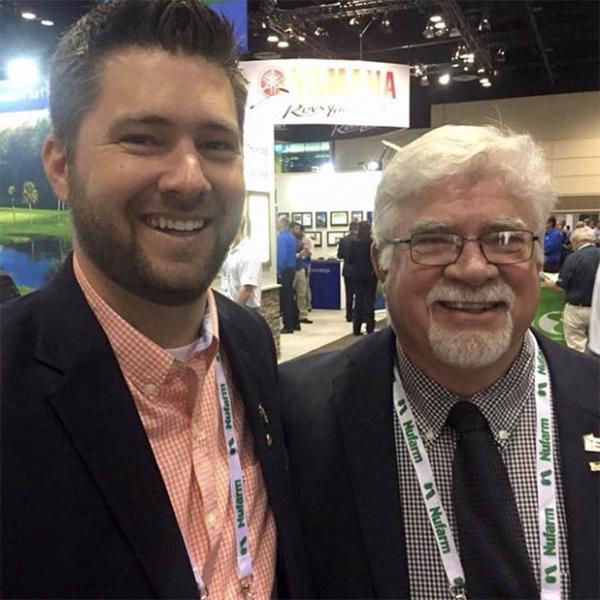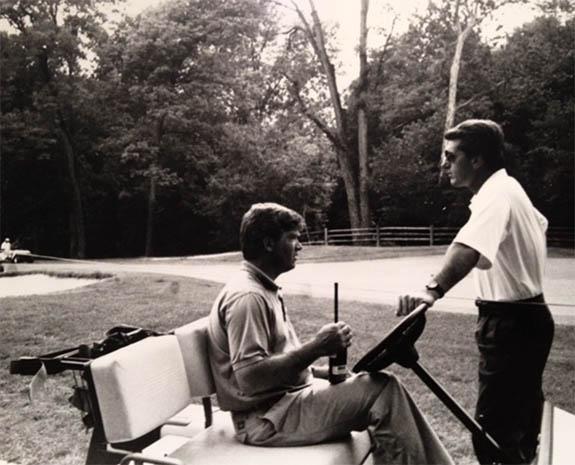Fifty years after he started in the golf business as a teenager mowing greens in Indiana, Terry Laurent's career highlight didn't come while preparing for a major championship. It came while playing in one.
 During his career, Laurent prepped for a lot of tournaments, including two U.S. Senior Opens during a 17-year run as superintendent at Saucon Valley Country Club in Bethlehem, Pennsylvania. It was his second Senior Open, in 2000, that still stands out to this day.
During his career, Laurent prepped for a lot of tournaments, including two U.S. Senior Opens during a 17-year run as superintendent at Saucon Valley Country Club in Bethlehem, Pennsylvania. It was his second Senior Open, in 2000, that still stands out to this day.There were an odd-number of players heading into the final two days, Mike Davis and Tim Moraghan of the USGA asked Laurent to play as a marker for Bill Tindall, a west coast teaching professional who was in the tournament.
"That was a dream come true," said Laurent, now 62.
"They asked me on Saturday and told me they'd call me the next morning if (Tindall) wanted a marker to play with him. We were working on the course at 4 a.m. The first tee time was 7 a.m. and at 6:30 they told me I was going to play. I had time to hit about four warm-up balls, then walked up to the first tee and had to hit it. I'd never played in front of a crowd before. I was so nervous. I just said to myself 'just get off the first tee, don't make a fool of yourself and don't hit anyone. I hit it into a fairway bunker that Jack Nicklaus had been in the day before, so I felt pretty good."
Laurent still remembers spending time on the practice range on Saturday evening in preparation for the Sunday round.
"My claim to fame, although he won't admit it, was hitting balls on the range with Tom Kite," he said. "There were just the two of us, him at one end and me all the way at the other. I stayed as far away as I could - so I wouldn't hit him."
Moraghan, who has been friends with Laurent since they first met during preparations for the '87 U.S. Senior Amateur, remembers offering some friendly advice that weekend.
"I told him that there were 1,000 people on the first tee, so just pick up if you get in the way," said Moraghan, now the owner of Aspire Golf. "He asked me if there was anything else he needed to know, and I told him, 'don't top one on the first tee in front of your members.' "
Just like that day in 2000, Laurent's career has been a whirlwind. After working for years on a golf course with no education, he decided at age 30 to enter turf school at Penn State . . . with a wife and two young children in tow. His career has included being a superintendent and accomplished amateur player, but also instructor and, since 2005, owner and operator.
Today, Laurent, whose son Brian is the executive director of the Ohio Turfgrass Foundation, is co-owner of Cross Creek Golf Club in Decatur, Indiana, which is an updated and lengthened version of the nine-hole course where his career began in 1967.
Decatur Golf Course was built in the 1940s as a nine-hole layout by Chicago golf course architect Robert Bruce Harris. A second nine holes and a new name were added during a late 1980s renovation.
"I grew up one block from this golf course. It was my second home growing up," he said.
"We would come in at 6 a.m., hand mow the greens, change cups and work until noon. Then we'd go home, eat and come back and play golf in the afternoon."
It was in those early days, working for Decatur superintendent and owner Luke Majorki, that Laurent realized he wanted to make a career of the golf business.
 A former minor league baseball player in the 1940s, Majorki was an accomplished golfer, agronomist and manager. He sold Decatur in 1978 to Steve Kreigh who today still owns the course along with Laurent.
A former minor league baseball player in the 1940s, Majorki was an accomplished golfer, agronomist and manager. He sold Decatur in 1978 to Steve Kreigh who today still owns the course along with Laurent.Laurent learned a lot from Majorki, including how to manage his game on the golf course.
"We all sat around the clubhouse hoping he would ask us to play with him," he said. "He was a very good player, and it was a big deal to get to play with him."
Majorki also taught him a lot about being a professional, including a tough lesson when Laurent was just 15 years old
"I was about 30 minutes late to work one day because I overslept. He grounded me. He sent me home for three days and told me to think about what I'd done," Laurent said. "I got in trouble with him once, and that was enough.
"He taught me everything about work ethic. He was a workaholic, as am I. I learned that from, and that's not necessarily a good thing."
During those early days at Decatur he also learned that he didn't want to work inside, opting instead for a life outside on the golf course. His goal early on was to buy Decatur and run it along with his wife, Terri. Eventually, however, he knew that if he wanted to follow that path he needed to learn the finer points of turf management first.
Already a husband and father of two young boys, he applied to Michigan State and Penn State at age 30, ultimately deciding on the latter for the opportunity to study under Joe Duich, Ph.D.
He landed a job straight out of college as a superintendent at Wilmington Country Club in Delaware, then moved on to Harbourtowne Golf Resort in Maryland. He quickly learned that a great plan and a great crew can't overcome things like an outdated irrigation system and no money in the budget.
"The grass really suffered," he said. "We were always putting Band-Aids on everything."
Much about golf has changed since those early days.
Equipment is better, newer low-use chemistries are more friendly to the environment and lower mowing heights - from three-sixteenths to one-quarter inch in the old days to 0.125 or lower today - have greens rolling faster than ever, but with increased disease pressure.
It also is a lot harder to make a buck running a golf course today than it was a generation or so ago. Saucon Valley was founded nearly 100 years ago by a group of Bethlehem Steel executives. Through the years, the company that once was the world's second-largest steel manufacturer, pumped a lot of money through Saucon Valley, until the company filed for bankruptcy in 2001 and went out of business two years later.
"A lot of his members also belonged to the big private clubs in Philadelphia. For a lot of them, Saucon Valley was their second club," Moraghan said. "Terry was under a lot of pressure to keep it as good as the other urban clubs. He met the challenge. I went there a lot during Terry's days, and there was never a blade of grass out of place."
More recently, Cross Creek has battled with other west-central Indiana golf courses for players. And although it has been a struggle at times, business finally is on the uptick.
"We're starting to see an increase now," he said. "For a while there it was a real struggle."
Instead of running the business with wife Terri, Laurent worked, for a while, with son Bryan before he left to start his own association management firm in Columbus, Ohio where he is the executive director of the Ohio Turfgrass Foundation.
Being a co-owner of the business has landed Laurent where he never wanted to be, inside searching for ways to grow his business.
"I have an assistant (superintendent) who reports to me, so I don't get outside on the golf course as much as I'd like to," Laurent said. "My son Brian was supposed to do all this for me, but he bailed out on me. You can tell him I said that."

